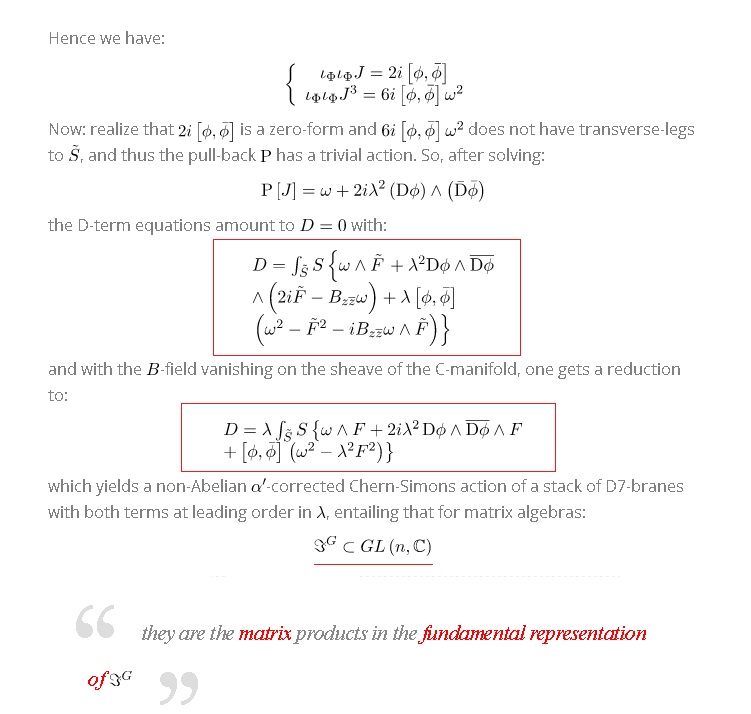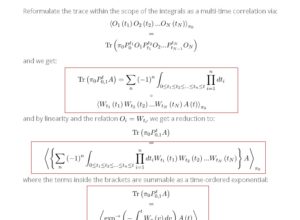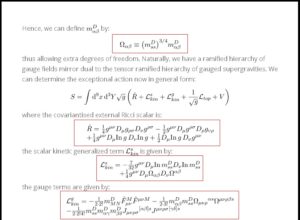Let us see how the Yukawa couplings among 4-D fermionic fields can be derived from the F-theory superpotential and relate them to the tree-level superpotential. This is of utmost importance since D7/D3-brane-phenomenology of 4-D F-theory can be promoted to M-theory in light of the F/M-theory duality and the compactness of Calabi-Yau 4-folds. Start with a Kähler coordinate expansion of ![]() which gives us, after inserting it in:
which gives us, after inserting it in:
![]()
the following:
![]()
which is the exact 7-brane superpotential for F-theory and the integrand is independent of ![]() , entailing that the F-term conditions are purely topological and in no need for
, entailing that the F-term conditions are purely topological and in no need for ![]() -corrections.
-corrections.
However, the D-term in:
![]()
is in need of ![]() -corrections, since it is evaluable as:
-corrections, since it is evaluable as:
![Rendered by QuickLaTeX.com \[\begin{array}{l}D = \int_{\tilde S} {S\left\{ {\lambda P\left[ J \right]} \right.} \wedge F - \frac{{i\lambda }}{6}{\iota _\Phi }{\iota _\Phi }{J^3} + \\\frac{{i{\lambda ^3}}}{2}{\iota _\Phi }{\iota _\Phi }J \wedge F \wedge F - {\rm{P}}\left[ {J \wedge B} \right] \wedge F\\\left. { + i{\lambda ^2}{\iota _\Phi }{\iota _\Phi }\left( {J \wedge B} \right) \wedge \frac{{i\lambda }}{2}{\iota _\Phi }{\iota _\Phi }\left( {J \wedge {B^2}} \right)} \right\}\end{array}\]](https://www.georgeshiber.com/wp-content/ql-cache/quicklatex.com-c8d76593dca97fc746a95bd9f07f823d_l3.png)
and the non-Abelian D-term has the form:
![]()
With ![]() our target Calabi-Yau 4-fold and Lie algebra
our target Calabi-Yau 4-fold and Lie algebra ![]() , for:
, for:
![]()
we have:
![]()
with ![]() and
and ![]() the Cartan matrix of
the Cartan matrix of ![]() , effectively reflecting the F/M-theory duality.
, effectively reflecting the F/M-theory duality.
In the local patch on the C-manifold, one takes the flat-space-Kähler-form as having the form:
![Rendered by QuickLaTeX.com \[J = \underbrace {\frac{i}{2}{\rm{d}}x \wedge {\rm{d}}\bar x + \frac{i}{2}{\rm{d}}x \wedge {\rm{d}}\bar y}_{ = :\omega } + 2i{\rm{d}}z \wedge {\rm{d}}\bar z\]](https://www.georgeshiber.com/wp-content/ql-cache/quicklatex.com-719e7d63efe47a17c5e22d2b783d44d4_l3.png)
Then, we decompose the Kähler-background B-field as:
![]()
with:
![]()
thus giving us:
![Rendered by QuickLaTeX.com \[\begin{array}{l}D = \int_{\tilde S} {S\left\{ {\rm{P}} \right.} \left[ J \right] \wedge \tilde F + \frac{{i\lambda }}{2}\left( {{\iota _\Phi }{\iota _\Phi }J} \right)\\ - \left( {{{\tilde F}^2} - {\omega ^2}} \right) - i\lambda \left( {{\iota _\Phi }{\iota _\Phi }B} \right)\omega \wedge \tilde F\\ - \omega \wedge {\rm{P}}\left[ {{B_{z\overline z }}{\rm{d}}z \wedge {\rm{d}}\bar z} \right]\end{array}\]](https://www.georgeshiber.com/wp-content/ql-cache/quicklatex.com-a0fe25124bde774846e7c3141c746fd2_l3.png)
with the Abelian pull-back ![]() to
to ![]() determined by:
determined by:
![Rendered by QuickLaTeX.com \[J = \underbrace {\frac{i}{2}{\rm{d}}x \wedge {\rm{d}}\bar x + \frac{i}{2}{\rm{d}}x \wedge {\rm{d}}\bar y}_{ = :\omega } + 2i{\rm{d}}z \wedge {\rm{d}}\bar z\]](https://www.georgeshiber.com/wp-content/ql-cache/quicklatex.com-719e7d63efe47a17c5e22d2b783d44d4_l3.png)
where locally the Higgs field is given by:
![]()
with ![]() a matrix in the complexified adjoint representation of
a matrix in the complexified adjoint representation of ![]() and
and ![]() its Hermitian conjugate. Thus, I could derive:
its Hermitian conjugate. Thus, I could derive:
![]()
with:
![]()
Hence we have:
![]()
Now: realize that ![]() is a zero-form and
is a zero-form and ![]() does not have transverse-legs to
does not have transverse-legs to ![]() , and thus the pull-back
, and thus the pull-back ![]() has a trivial action. So, after solving:
has a trivial action. So, after solving:
![]()
the D-term equation amounts to ![]() with:
with:
![Rendered by QuickLaTeX.com \[\begin{array}{l}D = \int_{\tilde S} {S\left\{ {\omega \wedge \tilde F} \right.} + {\lambda ^2}{\rm{D}}\phi \wedge \overline {{\rm{D}}\phi } \\ \wedge \left( {2i\tilde F - {B_{z\overline z }}\omega } \right) + \lambda \left[ {\phi ,\bar \phi } \right]\\\left. {\left( {{\omega ^2} - {{\tilde F}^2} - i{B_{z\overline z }}\omega \wedge \tilde F} \right)} \right\}\end{array}\]](https://www.georgeshiber.com/wp-content/ql-cache/quicklatex.com-92ef74f7300fefeb087fd6471cca8ad1_l3.png)
and with the ![]() -field vanishing on the sheave of the C-manifold, one gets a reduction to:
-field vanishing on the sheave of the C-manifold, one gets a reduction to:
![]()
which yields a non-Abelian ![]() -corrected Chern-Simons action of a stack of D7-branes with both terms at leading order in
-corrected Chern-Simons action of a stack of D7-branes with both terms at leading order in ![]() , entailing that for matrix algebras:
, entailing that for matrix algebras:
![]()
they are the matrix products in the fundamental representation of 
and so the ![]() -corrections on D-terms with the gauge flux F diagonalization yields
-corrections on D-terms with the gauge flux F diagonalization yields
the D-term equations
![]()
Deep upshot: the  -corrections are given entirely by the abelian pull-back of the Kähler-form
-corrections are given entirely by the abelian pull-back of the Kähler-form  to
to 
![]()
And this has a deep physical interpretation which can be extracted from the energy-momentum tensor and D-term of Q-clouds.
In the special case that is of interest, the Yukawa couplings among 4-d matter fields can be derived from the superpotential:
![]()
with ![]() the F-theory characteristic scale, and
the F-theory characteristic scale, and ![]() with dynamical dependence on the D-term:
with dynamical dependence on the D-term:
![]()
Our equations of motion that follow from the superpotential and the D-term are given by:
![]()
![]()
which are the F-term equations, and the following holds for our fundamental ![]() form on
form on ![]() :
:
![]()
which is the D-term equation.
In the bosonic case, to derive the equations of motion, define:
![]()
and expand the F-term equations and the D-term equation to first order in the fluctuations ![]() . Thus we find:
. Thus we find:
![]()
![]()
![]()
with the following relations:
![]()
and locally, we have the Kähler form:
![]()
Hence, our equations:
![]()
![]()
![]()
admit zero mode solutions that are localized on fermionic curves which are determined by the background of ![]() which in the absence of fluxes depends holomorphically on the complex coordinates of
which in the absence of fluxes depends holomorphically on the complex coordinates of ![]() . So, a nontrivial VEV
. So, a nontrivial VEV ![]() with the property that its rank changes at curves
with the property that its rank changes at curves ![]() implies that instead of a single
implies that instead of a single ![]() there are intersecting surfaces:
there are intersecting surfaces:
![]()
Now, at any point on ![]() ,
, ![]() splits
splits ![]() to
to ![]() times
times ![]() due to the 7-branes wrapping the
due to the 7-branes wrapping the ![]() , and at
, and at ![]() there are additional commuting generators whose associated fluctuations give rise to matter localized on
there are additional commuting generators whose associated fluctuations give rise to matter localized on ![]() as implied by solving the equations of motion. At point
as implied by solving the equations of motion. At point ![]() where the matter curves intersect, there is bi-uplifts to
where the matter curves intersect, there is bi-uplifts to ![]() . Locally, a worldvolume flux
. Locally, a worldvolume flux ![]() is included, entailing that a hypercharge generator exists that breaks
is included, entailing that a hypercharge generator exists that breaks ![]() to the
to the ![]() group.
group.
A sketch of the proof:
Take
![]()
such that:
![]()
with ![]() the mass parameter; thus we have a VEV breaking of
the mass parameter; thus we have a VEV breaking of ![]() to
to ![]() at generic points in
at generic points in ![]() and so the group is enhanced to:
and so the group is enhanced to:
![]()
at curves:
![Rendered by QuickLaTeX.com \[\left\{ {\begin{array}{*{20}{c}}{{\Sigma _a} = \left\{ {x = 0} \right\}}\\\begin{array}{l}{\Sigma _b} = \left\{ {y = 0} \right\}\\{..._{{._{{._{{._.}}}}}}}\end{array}\\{{\Sigma _n} = \left\{ {x = y} \right\}}\end{array}} \right.\]](https://www.georgeshiber.com/wp-content/ql-cache/quicklatex.com-dbf3b14f328567975bac52e4612c8aeb_l3.png)
The generators ![]() determined by:
determined by:
![Rendered by QuickLaTeX.com \[{E_{{a^ + }}} = \left( {\begin{array}{*{20}{c}}0&1&0&{...}\\0&0&0&{...}\\0&0&0&{...}\\0&0&0&0\end{array}} \right)\]](https://www.georgeshiber.com/wp-content/ql-cache/quicklatex.com-6d2179efde975cd89bc6cabc6f31b80b_l3.png)
with:
![]()
commute with ![]() when
when ![]() . Inducing chirality involves including the flux:
. Inducing chirality involves including the flux:
![]()
Under the holomorphic gauge ![]() such that:
such that:
![]()
solutions to the equations of motion are derived by gauge transformations, noting that equations:
![]()
and:
![]()
satisfy:
![]()
![]()
Hence, the following equations of motion:
![]()
![]()
![]()
admit an F-theory zero-mode local model and the Yukawa couplings tree-level superpotential:
![]()
includes the trilinear term:
![]()
leading to 4-d couplings – given by an integral of the zero mode wavefunctions – among the zero modes of ![]() and
and ![]() .
.
Solving the D-term equation:
![]()
we get a description of an F-theory-GUT model in the vicinity of a single point by computing the down-like Yukawa couplings:
![]()
or the up-like Yukawa couplings:
![]()
The proof, and the structure of the argument, generalizes to F-theory models with ![]() with differing
with differing ![]() , the most interesting cases being:
, the most interesting cases being:
![]()
![]()
![]()
and
![]()
all of which explicitly reflect the ‘no-two-time’ property of F-theory.



